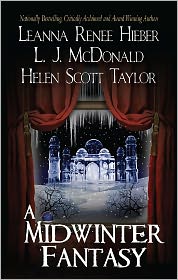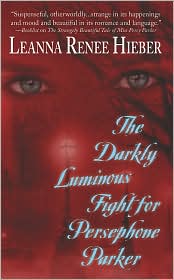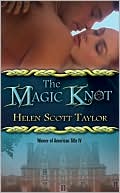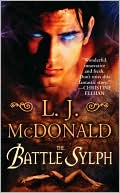 A Midwinter Fantasy is a collection of three novellas that take place at, of course, Midwinter. In all three of the stories, it is the festival of giving, but because all of the stories are fantasy romances, the holiday celebrated is not always or not exactly Christmas.
A Midwinter Fantasy is a collection of three novellas that take place at, of course, Midwinter. In all three of the stories, it is the festival of giving, but because all of the stories are fantasy romances, the holiday celebrated is not always or not exactly Christmas.
The first story in the collection is A Christmas Carroll by Leanna Renee Hieber, and the story is set in the same storyline as her Strangely Beautiful series. In fact, the action of this Christmas tale takes place directly after the events of The Darkly Luminous Fight for Persephone Parker.
Not being familiar with the previous tale, I felt like I had been dropped into the middle of a story, only because I had been. Once I caught up, things got a lot more interesting.
 The title of the story is a play on both Dickens’ classic and the name of one of the characters. The author’s world is a close parallel to our Victorian era, except that the Victorian fascination with spiritualism represents concern about a real, and sometimes dangerous threat. But the spirits of Hieber’s “Whisper-World”, can also help the living, just as Marley’s Ghost arranges in Dickens’ famous Christmas Carol.
The title of the story is a play on both Dickens’ classic and the name of one of the characters. The author’s world is a close parallel to our Victorian era, except that the Victorian fascination with spiritualism represents concern about a real, and sometimes dangerous threat. But the spirits of Hieber’s “Whisper-World”, can also help the living, just as Marley’s Ghost arranges in Dickens’ famous Christmas Carol.
The “Carroll” in Hieber’s story is Michael Carroll, and the spirits help both him and Rebecca Thompson to discover not the true meaning of Christmas, but the true meanings of both friendship and love in this wrap-up of her series.
Although enough of Michael and Rebecca’s story was told in flashbacks for me to empathize with them, I would have enjoyed this more if I had read the entire series. But I enjoyed it enough, and I was intrigued enough, that I plan on going back and reading everything!
 The Worth of a Sylph by L.J. McDonald is the second piece in the book. Lily Blackwell is an elderly woman who raises orphans in a remote house in Sylph Valley. She is also the human Master of a Battle Sylph named Mace. Mastery can be an equitable, loving arrangement, and in this case it is, although it is not always so. Sylphs provide the different types of magic that keep the Valley heated, the crops irrigated, provide water for washing, and protection, among other things. Linking to a master provides a Sylph with nourishment, including emotional sustenance, and a way of remaining in the world.
The Worth of a Sylph by L.J. McDonald is the second piece in the book. Lily Blackwell is an elderly woman who raises orphans in a remote house in Sylph Valley. She is also the human Master of a Battle Sylph named Mace. Mastery can be an equitable, loving arrangement, and in this case it is, although it is not always so. Sylphs provide the different types of magic that keep the Valley heated, the crops irrigated, provide water for washing, and protection, among other things. Linking to a master provides a Sylph with nourishment, including emotional sustenance, and a way of remaining in the world.
When the last of Lily’s orphans runs away, out of the Valley, she tasks Mace with retrieving the boy, no matter where he has gone. She also charges him with finding himself a new master before she dies, one that she can approve of. On Mace’s quest, he finds, not just the boy he was sent for, but a woman he can truly love and spend a life with, and not just one son, but two.
The story takes place during the Winter Festival, which is supposed to be celebrated with family. There is a message in the story that the family you create with love can be much stronger that the one you are born to.
Although Worth of a Sylph is also a part of a continuing series that begins with The Battle Sylph, it was much less obvious about it. I was able to jump right into the story and be involved with the characters right away. The story was complete in and of itself.
Last, but not least, the final story in this anthology is The Crystal Crib, by Helen Scott Taylor. I said not least, because the story deals with some larger than life figures, the Norse gods. Odin is the bad guy, having kept a father from his daughter for over 2,000 years, and enslaving his sons for the same length of time, all for crimes that other people committed. Odin is someone who really knows how to hold a grudge!
Sonja thinks she has come to Iceland to convince the owner of “Santa’s Magical Wonderland” to allow her Aunt’s travel company to arrange tours to his resort. Little does she know that the owner of the resort is Vidar, the son of Odin, and, is also the “Guardian Angel” who has been protecting her all of her life. And, that her life has been considerably longer than the scant decades she remembers.
Her unexpected presence in Odin’s backyard forces a confrontation among the gods, monsters and angels who have protected her for her entire existence, and brings surprising dangers and rewards to everyone in her path. This was a story about love truly conquering all.
 This story is set in the same universe as Taylor’s The Magic Knot, but it reads as a stand-alone. I read it as someone playing tricks on Odin, which, considering the story, and considering other stories about Odin, seemed perfectly fair to me. However, this was also the least satisfying of the three stories. I wanted a lot more explanation for a 2,000 year old grudge than I got. And the heroine took the fact that she had been in suspended animation for those same two millennia a bit too much in stride, especially factoring in that her lover had been watching over her the entire time! Oh, and she might not die, ever. There was a bit too much fantasy in this fantasy.
This story is set in the same universe as Taylor’s The Magic Knot, but it reads as a stand-alone. I read it as someone playing tricks on Odin, which, considering the story, and considering other stories about Odin, seemed perfectly fair to me. However, this was also the least satisfying of the three stories. I wanted a lot more explanation for a 2,000 year old grudge than I got. And the heroine took the fact that she had been in suspended animation for those same two millennia a bit too much in stride, especially factoring in that her lover had been watching over her the entire time! Oh, and she might not die, ever. There was a bit too much fantasy in this fantasy.
Out of three stories, I vote Sylph very satisfying and complete, Carroll good and intriguing enough to make me want more, and Crystal not satisfying enough to make me go back for a return visit to the author’s world. YMMV.
Escape Ratings: Christmas Carroll B+, Worth of a Sylph, A and, The Crystal Crib, C.


